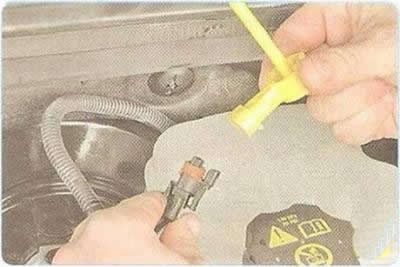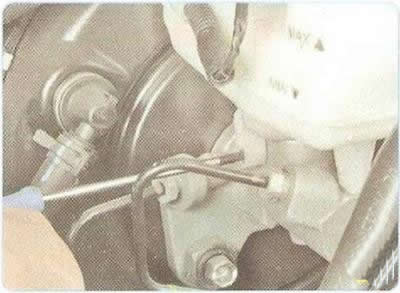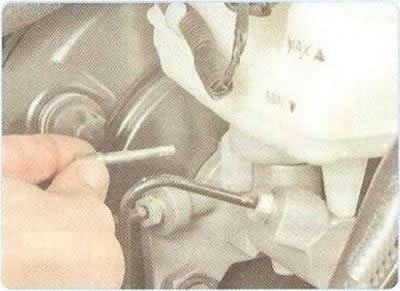1. Disconnect the wire from the terminal «minus» battery.

2. Unscrew the cap of the reservoir of the main brake cylinder...

3.... and pump out the brake fluid from the tank, for example, with a large medical syringe.

4. Remove the brake fluid level sensor from the reservoir...

5.... squeeze the clamps, disconnect the wiring harness block from the adapter block of the brake fluid level sensor.

6. Disconnect the harness from the brake reservoir bracket.

7. Turn out the screw of fastening of a tank to the main brake cylinder...

8.... and remove the screw.

9. Disconnect the clutch release cylinder hose from the brake master cylinder reservoir.
Helpful Hint: Immediately after disconnecting the clutch hydraulic hose from the reservoir, plug its hole or pinch the hose without lowering it down. A certain amount of working fluid will remain in the hose, therefore, after installing the tank and connecting the hose to it, it will not be necessary to remove air from the clutch hydraulic actuator.

10. Pull up and remove the tank, removing its nozzles from the connecting sleeves.

11. Remove the connecting sleeves from the holes in the cylinder body. Reuse of connecting sleeves is not allowed, replace them with new ones.
12. Before installing the tank, insert connecting sleeves 3 and 4 into the hole of the main brake cylinder (pic. 9.7). Then install the tank by inserting its nozzles into the connecting sleeves 3 and 4 by hand until it stops, and fix it with a screw.

Pic. 9.7. Master brake cylinder: 1 - piston pusher; 2 - cylinder mounting flange; 3, 4 - connecting sleeves; 5 - body of the brake cylinder; 6, 7 - connecting holes of pipelines; 8 - hole for the tank mounting bolt; 9 - rubber sealing ring
Helpful Hint: Moisten the connecting sleeves with fresh brake fluid to make it easier to install the reservoir.
13. Fill in the brake fluid and bleed the air from the hydraulic drive (see «Brake Fluid Replacement»).
